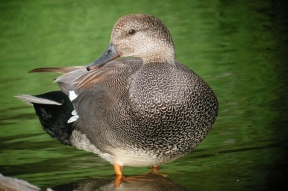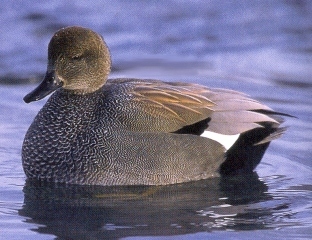|

Large dabbling
duck with finely barred gray body, black rump and undertail coverts,
white belly, and rust-brown shoulders. Head and neck are gray-brown;
bill is gray. Wings have black-bordered white speculum most visible
in flight. Legs and feet are yellow.
Fast direct flight.
The breeding male Gadwall has a gray body, black rump and undertail
coverts, white belly, and rust-brown shoulders. The head and neck are
gray-brown and the bill is gray.
The legs and feet are yellow.

|
GADWALL
Anas strepera
ANSERIFORMES
Geese and Ducks (Anatidae)
Range
and Habitat
Breeds near seasonal and semi-permanent wetlands, mainly in the shortgrass,
tallgrass, and mixed prairie regions of the U.S. and Canada. Spends
winters in southern two-thirds of the U.S., with greatest concentrations
found in the Central and Mississippi Flyways; also a common winter visitor
to Guatemala. Preferred habitats include large, shallow ponds with lots
of marsh plants.
The Gadwall duck was first described by Linnaeus in his Systema
naturae in 1758 under its current scientific name. It is not as gregarious
as some dabbling ducks outside the breeding season and tends to form
only small flocks.
A group of ducks has many collective nouns, including a "brace",
"flush", "paddling", "raft", and "team"
of ducks.

The range of the Gadwall is approximately 10 million kilometers. The
population of this bird species is around 4 million individual birds.
The previous rating for this bird was Lower Risk. That rating was updated
in 2004 to reflect the current large range and population of the Gadwall.
This bird species can be found
in many countries throughout the world. At this time, there are no known
serious dangers facing the Gadwall which might precipitate population
decline in the near future.

|